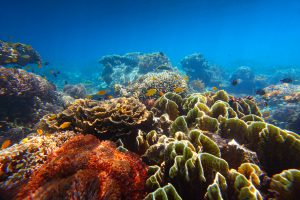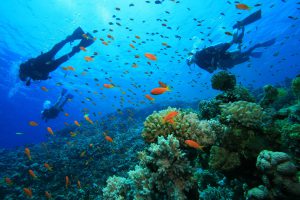
Better Management of Protected Areas in PH as E-Nipas Act Signed Into Law
A new and improved Republic Act 7586 or the National Integrated Protected Areas System (Nipas) was signed into law on June 22 by President Rodrigo Duterte.
The Republic Act 11038 or the Expanded National Integrated Protected Areas System (E-Nipas) Act aims to increase the number of protected areas and national parks, expand the areas covered by these areas, as well as impose a stricter penalty and higher fines against violators of the law.
The signing was well-received by biodiversity conservation government officials and experts since it will help in protecting and conserving the rich biodiversity of the country.
Expanded Coverage
Under the old Nipas, there are 240 protected areas. However, only 13 of those are backed by laws. The rest was covered by executive orders and presidential proclamations, which can be disestablished by the Department of Environment and Natural Resources (DENR) upon the recommendation of the Protected Area Management Board (PAMB).
The E-Nipas changes that by increasing the protected areas backed by laws from 13 to 107. This provides better protection against destructive development projects such as quarrying, logging, and mining. The law also enhances the protection of the country’s key biodiversity areas like plants and animal wildlife, some of which are endemic to the Philippines.
Environment Undersecretary, for Policy, Planning and International Affairs and the concurrent Spokesman of Environment Secretary Roy A. Cimatu Jonas R. Leones told the BusinessMirror in a telephone interview on July 3 that E-Nipas fulfills the Nipas law because it adds more protected areas that are backed with legislation This means expanded coverage in terms of land area, both in the terrestrial and marine territory.
“With this E-Nipas law, we have substantially fulfilled Nipas with the additional protected areas being covered by the law,” said Jonas R. Leones, Environment Undersecretary, for Policy, Planning and International Affairs and Spokesman of Environment Secretary Roy A. Cimatu.
“We expect more funding and stronger protection for these protected areas under E-Nipas. The law provides for the legal framework for additional funding for their protection,” he added.
A More Adaptive Law
“We preserve the ecosystem and at the same time enhance our adaptive capacity. With this law, we expect that we will have a more proactive [local government units ] to form the [PAMB] and formulate their respective Protected Area Management Plan,” said Environment Undersecretary for Climate Change and Mining Concerns Analiza R. Teh.
Teh also expects an increased budget allocation by 2020 to be used for the 107 protected areas as well as those that are not yet covered with legislation.
In a statement, Rep. Josephine Ramirez-Sato of Occidental Mindoro, the principal author of the original bill in the House of Representatives, said that E-Nipas places 94 protected areas together totalling to a land area of 3.5 million hectares, which is then added to the list of legislated protected areas.
To reduce carbon emissions, the Philippines is adopting a massive tree-planting strategy. The goal is to cut down carbon emissions by 70 percent from 2020 to 2030 as part of its commitment under the 2015 Paris Agreement.
The Philippines is one of the signatories to various international treaties such as the Convention on Biological Diversity (CBD). With the establishment of protected areas, the country is effectively preventing biodiversity loss.

Increased Budget
According to Ramirez-Sato, what the E-Nipas does is basically increase the budget for protected areas from P65 million per year to possibly P535 million, which is approximately 823 percent in the annual General Appropriations Act.
A bigger budget simply means that the rehabilitation and development and the protection against hunting or harvesting of wildlife resources are well-financed.
Ramirez-Sato also added that the signing of the E-Nipas shows the country’s commitment in strengthening protected area management.
“Truly, the signing of E-Nipas into law is one big step toward sustainability and a greener tomorrow for the present and future generation,” she said.
Chairman of the Senate Committees on Environment and Natural Resources and on Agriculture Sen. Cynthia A. Villar considers the E-Nipas Act crucial in ensuring the protection of the country’s natural resources.
“The Philippines’s rich biodiversity is a source of pride and joy for all of us Filipinos. We actively protect and strongly defend the breadth and depth of our territories to ensure that the future generation of Filipinos will still have the opportunity to take pride and find joy in our country’s rich biodiversity,” said Villar in a statement.
Marine Resources Protection
Oceana Philippines, an ocean conservation advocacy group, praised the enactment of the E-Nipas.
“We laud the timely passage of the E-Nipas Act. It will enhance the conservation efforts undertaken in our unique but vastly threatened biodiversity and ecosystems, including our marine habitats,” said Vice President of Oceana Philippines Attorney Gloria Estenzo Ramos.
“As the ‘center of the center’ of marine biodiversity in the world, it is high time that our biologically significant protected areas be given the highest priority and protection they deserve, to ensure that our national treasures continue to sustain the current and the future generations of Filipinos,” she added.
The E-Nipas Act, according to Ramos, will help ensure the ecological integrity of protected areas such as the Tañon Strait Protected Seascape, one of the largest marine protected areas in the Philippines and was declared as a protected seascape in 1998 through a presidential proclamation.

Important Provisions
Aside from expanding the protected areas and increasing the budget, the E-Nipas also has provisions including the scientific and technical support for biodiversity conservation, delineation and demarcation of boundaries, regular reporting on the status of the Integrated Protected Area Fund, and allocating 75 percent of all revenues raised to the PAMB.
Ramos also mentioned that the law prohibits the use and possession of destructive fishing gears within the protected seascape. The law also mandates the Department of Justice to appoint special prosecutors when handling cases related to protected areas and assist in the training of wardens and rangers in arrests and criminal procedures.
Perfect Timing
Executive Director Theresa Mundita S. Lim of the Asean Centre for Biodiversity who is also a former director of the Biodiversity Management Bureau of the DENR said that the signing of E-Nipas Act by President Duterte is very timely.
“Right now, we are developing here at the United Nations Convention on Biological Diversity Meeting in Montreal [Canada] recommendations on how to better achieve the Aichi Biodiversity Target 11. These recommendations shall be put forward eventually as decisions at the CBD Conference of the Parties in Egypt in November. Thus, we are so proud to receive this good news from Manila,” she said.
According to the Aichi Biodiversity Target 11: “by 2020, at least 17 percent of terrestrial and inland water, and 10 percent of coastal and marine areas, especially areas of particular importance for biodiversity and ecosystem services, are conserved through effectively and equitably managed, ecologically representative and well connected systems of protected areas and other effective area-based conservation measures, and integrated into the wider landscapes and seascapes.”
“As chairman of the [Montreal] meeting and as ACB executive director, we are finding ways to highlight this in the Conference by spreading the good news among colleagues in Asean and with partners,” Lim said.
“Other than the additional 94 national parks, covering about 3 million ha from only 13 previously enacted protected areas of around 800,000 hectares, the law now provides more incentives to protect the protected areas, but also stiffer [penalties] when it comes to violators and exploiters of these high biodiversity areas,” she noted.
Lim also hoped that the new law will compel local government units in close proximity to the protected areas to come up with plans and programs that will help them effectively manage parts of the protected areas within their jurisdiction.
“It is my hope that with this law, if properly enforced, will enable the Philippines to maximize the benefits of its rich biological diversity, and scale up these efforts, as well as these benefits, at the regional level,” Lim said.
According to Lim, the benefits of protected areas are being discussed in the CBD meeting. One document states that: “Protected areas safeguard the biodiversity and ecosystems that underpin the Sustainable Development Goals. Protected areas are especially important in achieving goals related to poverty alleviation, water security, carbon sequestration, climate-change adaptation, economic development and disaster-risk reduction.
“Protected areas are an essential strategy for the emerging field of nature-based solutions to various global challenges, such as water security. They are particularly important as a nature-based solution for climate mitigation and climate adaptation. Nature provides at least a third of climate solutions if the planet is to stay under 1.5 degrees Celsius, and protected areas are an essential strategy for achieving this goal.”
via Business Mirror / Jonathan L. Mayuga




